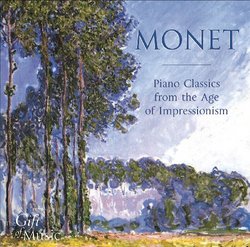| All Artists: Martin Souter Title: Monet: Piano Classics From the Age of Impressionism Members Wishing: 0 Total Copies: 0 Label: The Gift of Music Original Release Date: 1/1/2002 Re-Release Date: 3/3/2001 Genre: Classical Styles: Forms & Genres, Suites, Historical Periods, Modern, 20th, & 21st Century, Symphonies Number of Discs: 1 SwapaCD Credits: 1 UPC: 658592104127 |
Search - Martin Souter :: Monet: Piano Classics From the Age of Impressionism
 | Martin Souter Monet: Piano Classics From the Age of Impressionism Genre: Classical
Monet Piano Classics from the Age of Impressionism Sophisticated sounds, beautiful harmonies and evocative titles - superb piano music from France in the age of impressionism, from the elegant preludes of Debussy to Satie'... more » |
Larger Image |
CD Details
Synopsis
Product Description
Monet Piano Classics from the Age of Impressionism Sophisticated sounds, beautiful harmonies and evocative titles - superb piano music from France in the age of impressionism, from the elegant preludes of Debussy to Satie's beautiful miniature masterpieces and the grandeur of Ravel's superb style, in a programme of relaxing and haunting sounds. Martin Souter, piano The artists of The Age of Impressionism created some of the most famous and well-loved paintings of all time. Impressionist masterpieces are famous, and frequently reproduced. Their style is studied and copied, and their influence has been constantly strong throughout the last century. Claude Monet's style was to suggest an effect - an impression - and to give us a new view of the world which moved decisively away from the naturalistic art of previous generations. His musical equivalents also sought a new expression, a blurring of the boundaries of conventional harmonies and musical rhythms to create new musical effects which could conjure up scenes in the mind with great accuracy and speed. Just as Monet sought to express his inner vision of the colours and shapes of the world around him, so Debussy, Ravel and others learnt by experiment to create musical works which were suggestive of a moment, or a scene. The listener is free to let his imagination roam, inspired by the faintest hint of suggestions in the music. Thus, in la terrasse des audiences du clair de lune, Debussy's evocative score points us in the direction of listeners, perhaps in an ancient amphitheatre at night, listening and watching as a performance of music, or drama, takes place. Debussy's skill is to suggest enough, but leave space for our own thoughts and imagination to take over. In La cathédrale engloutie Debussy conjures up the mythical sunken cathedral of Ys, which appears from beneath the waves in full glory, before sinking back again, and leaving us with only a memory of the vision, and the gentle movement of the waves. Erik Satie was an eccentric composer. His music often has strange titles, and was nearly always very advanced for its time. In the three Gnossiennes, Satie creates the illusion of time standing still, through the repetitive rhythms and slow melodies. These pieces are a superb example of how music can heal and relax the busy mind. Debussy's Canope is similarly still. This short prelude evokes an ancient Egyptian city, and through its stillness suggests something eternal and calm. Ravel's Pavane is one of his most famous works. It was written to honour a Spanish Princess who died while still a child. The work is hauntingly beautiful, calm and steady. His Sonatine is a series of fleeting movements in an almost antique style, again evocative and calm, even in the final, glittering last movement. Debussy's Clair de lune is also famous, its moonlight scenes recalling the terrasses of track 2. His Arabesque No 1 rolls the music around the keyboard and completes the dreamy mood of the album.

 Track Listings (14) - Disc #1
Track Listings (14) - Disc #1